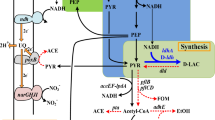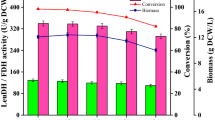Abstract
Coupling lactate fermentation with cell growth was investigated in shake-flask and bioreactor cultivation systems by increasing aeration to improve lactate productivity in Escherichia coli CICIM B0013-070 (ackA pta pps pflB dld poxB adhE frdA). In shake-flasks, cells reached 1 g dry wt/l then, cultivated at 100 rpm and 42°C, achieved a twofold higher productivity of lactic acid compared to aerobic and O2-limited two-phase fermentation. The cells in the bioreactor yielded an overall volumetric productivity of 5.5 g/l h and a yield of 86 g lactic acid/100 g glucose which were 66% higher and the same level compared to that of the aerobic and O2-limited two-phase fermentation, respectively, using scaled-up conditions optimized from shake-flask experiments. These results have revealed an approach for improving production of fermentative products in E. coli.

Similar content being viewed by others
References
Amrane A, Prigent Y (1998) Influence of yeast extract concentration on batch cultures of Lactobacillus helveticus: growth and production coupling. World J Microbiol Biotechnol 14:529–534
Feng Y, He Z, Ong SL, Hu J, Zhang Z, Ng WJ (2003) Optimization of agitation, aeration, and temperature conditions for maximum [beta]-mannanase production. Enzyme Microb Technol 32:282–289
Grabar TB, Zhou S, Shanmugam KT, Yomano LP, Ingram LO (2006) Methylglyoxal bypass identified as source of chiral contamination in l (+) and d (−)-lactate fermentations by recombinant Escherichia coli. Biotechnol Lett 28:1527–1535
Jiang GR, Nikolova S, Clark DP (2001) Regulation of the ldhA gene, encoding the fermentative lactate dehydrogenase of Escherichia coli. Microbiology 147:2437–2446
Luedeking R, Piret EL (1959) A kinetic study of the lactic acid fermentation. Batch process at controlled pH. J Biochem Microbiol Tech Eng 1:393–412
Norma VC, Luis C, Néstor P, Octavio R, Mauricio TR (2010) Production of recombinant proteins in E. coli by the heat inducible expression system based on the phage lambda pL and/or pR promoters. Microb Cell Fact 9:18–24
Shiloach J, Fass R (2005) Growing E. coli to high cell density—a historical perspective on method development. Biotechnol Adv 23:345–357
Tolosa L, Kostov Y, Harms P, Rao G (2002) Non-invasive measurement of dissolved oxygen in shake flasks. Biotechnol Bioeng 80:594–597
Vemuri GN, Eiteman MA, Altman E (2002) Succinate production in dual-phase Escherichia coli fermentations depends on the time of transition from aerobic to anaerobic conditions. J Ind Microbiol Biotechnol 28:325–332
Villaverde A, Benito A, Viaplana E, Cubarsi R (1993) Fine regulation of cI857-controlled gene expression in continuous culture of recombinant Escherichia coli by temperature. Appl Environ Microbiol 59:3485–3487
Yamané T, Shiotani T (1981) Interrelationship among specific rates of cell growth, substrate consumption, and metabolite formation in some simple microbial reactions producing primary metabolites. Biotechnol Bioeng 23:1373–1387
Zhao K, Liu M, Burgess RR (2005) The global transcriptional response of Escherichia coli to induced σ32 protein involves σ32 regulon activation followed by inactivation and degradation of σ32 in vivo. J Biol Chem 280:17758–17768
Zhou S, Causey TB, Hasona A, Shanmugam KT, Ingram LO (2003) Production of optically pure d-lactic acid in mineral salts medium by metabolically engineered Escherichia coli W3110. Appl Environ Microbiol 69:399–407
Zhou S, Shanmugam KT, Yomano LP, Grabar TB, Ingram LO (2006) Fermentation of 12% (w/v) glucose to 1.2 M lactate by Escherichia coli strain SZ194 using mineral salts medium. Biotechnol Lett 28:663–670
Zhou L, Zuo ZR, Chen XZ, Niu DD, Tian KM, Prior BA, Shen W, Shi GY, Singh S, Wang ZX (2011) Evaluation of genetic manipulation strategies on d-lactate production by Escherichia coli. Curr Microbiol 62:981–989
Zhu Y, Eiteman MA, DeWitt K, Altman E (2007) Homolactate fermentation by metabolically engineered Escherichia coli strains. Appl Environ Microbiol 73:456–464
Zhu Y, Eiteman MA, Altman E (2008) Indirect monitoring of acetate exhaustion and cell recycle improve lactate production by non-growing Escherichia coli. Biotechnol Lett 30:1943–1946
Acknowledgments
This work was partly funded by the Sino-South Africa Cooperation Program 2009DFA31300 and the National Natural Science Foundation of China No. 21006039.
Author information
Authors and Affiliations
Corresponding author
Additional information
Li Zhou and Kang-Ming Tian have equal contribution.
Electronic supplementary material
Below is the link to the electronic supplementary material.
Rights and permissions
About this article
Cite this article
Zhou, L., Tian, KM., Niu, DD. et al. Improvement of d-lactate productivity in recombinant Escherichia coli by coupling production with growth. Biotechnol Lett 34, 1123–1130 (2012). https://doi.org/10.1007/s10529-012-0883-x
Received:
Accepted:
Published:
Issue Date:
DOI: https://doi.org/10.1007/s10529-012-0883-x




